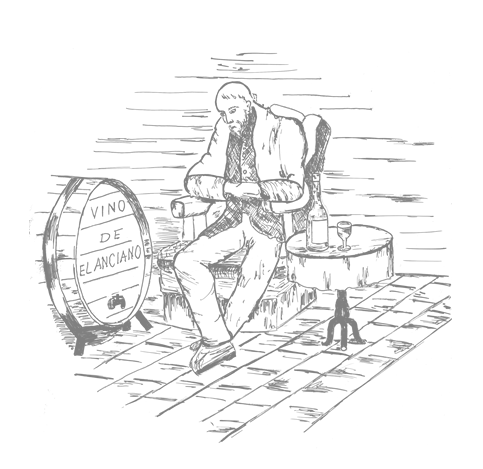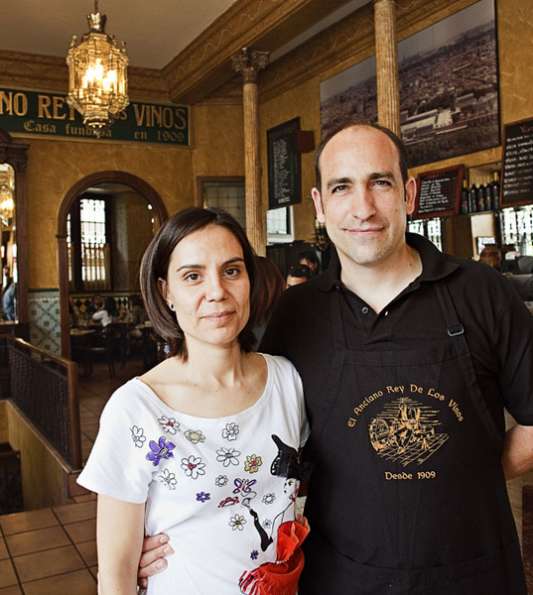A Century-old tradition
The Anciano Rey de los Vinos preserves the authenticity of the “Castizo” and traditional Madrid in a privileged environment
Silent witness of the last hundred years
We are talking about a hundred-year-old tavern and a very traditional Spanish one situated in a privileged area because the terrace overlooks the Royal Palace and the Almudena Cathedral which are just opposite the street. The building was erected around 1886. In those days, there was another tavern called “Casa Pedro Martínez” on 19 Bailen Street where now our Anciano is situated. In that tavern, coffee de puchero (prepared in an earthenware pot), aguardiente (clear brandy distilled from fermented fruit juice) and tea were sold as in many other bottle shops and taverns of that time.
In 1909, its owner Pedro Martínez transferred the tavern to Luis Montón and this was the time when the Anciano was founded as such. Luis Montón registered the wine trademarks “el Viejo”, “los Viejos” and “el Anciano Rey” and was in charge of the business until 1942 when his nephew, Abilio Manzanal Ortega, started to run the tavern.

This madrileña tavern received the award that the City Council gave to businesses that were 100 years old, respect for tradition and love for the job well done are the keys to these businesses, which are mostly family businesses. This special award is a plaque designed by Mingote and it is placed just next to one of the entrances to the tavern, easily seen on the pavement.

Repúblic, Civil War...
During Abilio’s time, the primitive walnut bar disappeared in 1958 as it had become small and he was unable to find anyone who could make it bigger; consequently, he decided to replace it with a new one with a bakelite countertop and a stainless steel tray.
During the Republic, it was forbidden to use the word REY and so it was eliminated from the sign and the tables. Afterwards, during the Spanish Civil War, the tavern was closed, as many other taverns, but in 1940 when the conflict finished it was redecorated with the glazed tiles that can still be admired today.
Constancio Cortes Hernández started to work behind this bar when he was fifteen years old; he started as a waiter when Manzanal was the owner in 1948. In 1970, when he was in his 30s, he became the new owner and he worked there until 2003 when he retired. He passed the baton on to his daughter, Belén Cortés Borges who has been running the tavern since then. Among her collaborators, it’s worth mentioning her husband, Alejandro Casado Manrique; currently, they both run the business with great enthusiasm introducing gradually some changes in the menu and in the business approach but keeping the traditional castiza image of the tavern.

It was the nephew of the founder who opened the doors of the Anciano Rey de los Vinos to the present owner family. It was the year 1948 when Constancio Cortés Hernández crossed the threshold of the tavern for the first time. At the tender age of fifteen years, Constancio began to work hard behind the bar of the establishment.
With a clear vocation of service and with the traditional know-how, he turned thirty behind the tavern that in those years he saw change. It was then, at the beginning of the seventies of the twentieth century, when Constancio acquired the tavern, continuing in it until his retirement in 2003. With Constancio retired, the management of El Anciano Rey de los Vinos rests with his daughter Belén Cortés Borges, who continues to lead the tavern supported by his husband, Alejandro Casado Manrique.
The arrival of Belén and Alejandro supposes new sap for the operation of the tavern. Without renouncing the idiosyncrasy of the establishment, that is, its traditional soul and traditional image, the young owners introduce some changes in the menu and in the management. And yes, waiters with a career of more than 40 years in the house, as Estanislao, continues behind the bar of the Anciano Rey de los Vinos.


